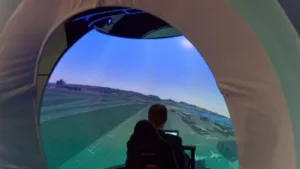Esterline was showing a couple of its complete small simulation systems at the event.
The first was created with Cruden which specialises in maritime and boat simulators. The Esterline simulator dome is designed to be readily easily transportable – all components, for example, can be passed through a standard door. The dome surface is a single piece of material, but can be rolled up to be transported. The lack of seams makes the environment immersive without extra work. The surface is fitted with magnets on the frame so that the dome can be assembled in just four hours. At the show, the dome was enclosed in an outer ‘tent’ that reduces ambient light, but we heard that it works pretty well even in regular environments without the tent.
The dome is typically used in three channel or five channel set-ups and covers 270º x 90º.
 Esterline showed this Portable dome which was achieving good contrast for a front projection system. Image:Meko
Esterline showed this Portable dome which was achieving good contrast for a front projection system. Image:Meko
Esterline, of course, also makes full size systems and we heard about a 7 metre dome that is being used by BAE, Wharton, UK, which has a 16 channel visual system and is being used to train F35 pilots for the short take off procedure.
Esterline said that its highest resolution simulators now use 13 ten megapixel projectors which gives a resolution of 4 arc minutes per line pair – not as high as to match the acuity of human vision, but the highest currently practical. The company also told us that when possible it likes to put in rear projection systems because the system contrast can be increased to around 25:1, compared to the 6:1 to 8:1 that is possible in a system using a reflective dome.

